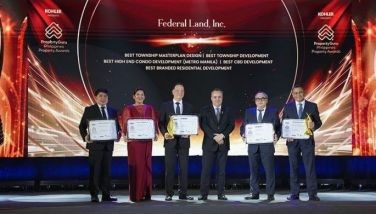‘Information warfare’
SYDNEY – It’s been a long while since I took a media-related trip abroad after the outbreak of the COVID-19 pandemic. Before the global COVID-19 lockdown took place, we were in Switzerland along with a few Filipino journalists invited to a private company-organized media trip. Luckily for us, we were able to fly back to Manila in late January 2020 before the pandemic lockdown in the Philippines was imposed two months later.
Travels everywhere else in the world resumed to the fullest in the “new normal” as we exited from the deadly pandemic period.
And by stroke of luck, I was invited to participate in the Information Technology Forum 2024 being held this year in Australia. So it was indeed a pleasant surprise and experience to see the big improvements at the Terminal 3 of the Ninoy Aquino International Airport (NAIA). Despite these big changes, passengers will still really have to bear with the hassles of long queues at the NAIA Terminal 3.
Going to NAIA at least four hours before flight time is really a must. With an 8 o’clock evening flight, I arrived at 4:30 p.m. at the airport. Terminal 3 is definitely much bigger than NAIA 1. But soon, NAIA is set to undergo massive repair and rehabilitation in a project led by the San Miguel conglomerate of Ramon S. Ang.
The four-hour allowance is on top of the amount of time needed to travel through the traffic gridlocks going to the NAIA terminals. Coming from Paranaque City, the last traffic hurdle is at the ramp going up the NAIA departure area due to the usual prolonged send-off goodbyes of Filipino families.
There is no more x-ray checking at the entrance gates. The big queue starts at the airline counters for a direct flight to Sydney via Qantas Airlines. Ground personnel did not even try to help their own passengers, like giving basic information that there is a special lane for senior citizens to ease and shorten the snake-like lines of people going to the counters.
Then second queuing takes place at the Immigration area. There were nine rows of departing passengers inching slowly to a few open Immigration counters. Supposedly, online transactions make your life easier using the government’s electronic travel, or e-travel application for both Immigration and Customs.
Still, a long queue continues at the Customs and airport security examination areas. Half of the rows at the Immigration area get clogged by passengers removing their belts, shoes, jackets, etc. and putting them on the trays before going through the revolving x-ray machine.
Yet, the Manila International Airport Authority (MIAA), the Bureaus of Immigration and of Customs are all aware of the busiest times of the day for departures.
So why not open all counters during these hours when there would be so much volume of departing passengers?
If it was any consolation, we breezed through the seven hours and 30 minutes flight from Manila to Sydney. Thank God, there was no sudden unexplained turbulent incident.
So we were able to attend this forum jointly organized by the US embassy and consulates in Australia. This year’s international forum was held here at the University of Technology Sydney (UTS). Handled by the UTS Centre for Media Transition (CMT), the two-day forum – which will end today – brought together four senior editors/journalists from each of the invited countries, namely, India, Indonesia, Malaysia and the Philippines.
This year’s event takes off from the last year’s forum that came out with a report on how Australian newsrooms are adopting generative artificial intelligence, or GenAI for short. The same report discussed “the impact on the production of public interest journalism and the challenges it poses for the integrity of the news information ecosystem.”
On the first day of the forum, participants shared the professional challenges of protecting information in the newsrooms “on broader media ecosystem in the regional newsrooms.” CMT co-director Monica Attard formally opened the forum yesterday with Marian Adrei-Rizolu, associate professor of UTS at the Data Science Institute, as the keynote speaker.
Today, the CMT will facilitate roundtable discussions on policy solutions, with additional inputs from Australian academic experts and the news media industry in the region. At the outset, the forum premises that credible information and journalism sources are challenged by social media and closed online groups from India to Malaysia to Indonesia and the Philippines, not to mention Australia where its journalists are on a work strike for a week now. The journalists and media practitioners from these participating countries will take up how they cope with “the huge investments” made in GenAI, especially the technology produced by the foreign “big tech” companies.
The forum noted the news organizations from these countries broadly agree the impact of GenAI technology on news production “is limited so far, to some extent crimped by languages other than English and the relative costs of local content production.”
The forum winds down with assessing the cost of doing nothing as generative AI approaches.
As duly cited in this forum, “newsrooms’ awareness of global best practices for information integrity is relatively high but implementation is generally weak.” It further cited “the inability of these countries to influence foreign ‘big tech’ has also ramped up efforts to rush through laws that compel these companies to comply with take-down notices of allegedly illegal content and to censor and change content that is allegedly contrary to socio-political values.”
So how will editors navigate GenAI if the government itself is not on board? How might GenAI make “information integrity” better or worse?
In the face of the misleading information and outright dis-information campaigns with the aid of social media technology, our job as editors to discern the truth and the facts becomes more difficult. The so-called “Information Warfare” is intensifying and the media is at the center of the battlefield for the hearts and minds of the people.
With the “deep fakes” and “fake news” coming out loosely in media, wherever it originated, the onset of political fever in the Philippines ahead of the May 2025 elections bodes more challenges to us in media.
- Latest
- Trending
























